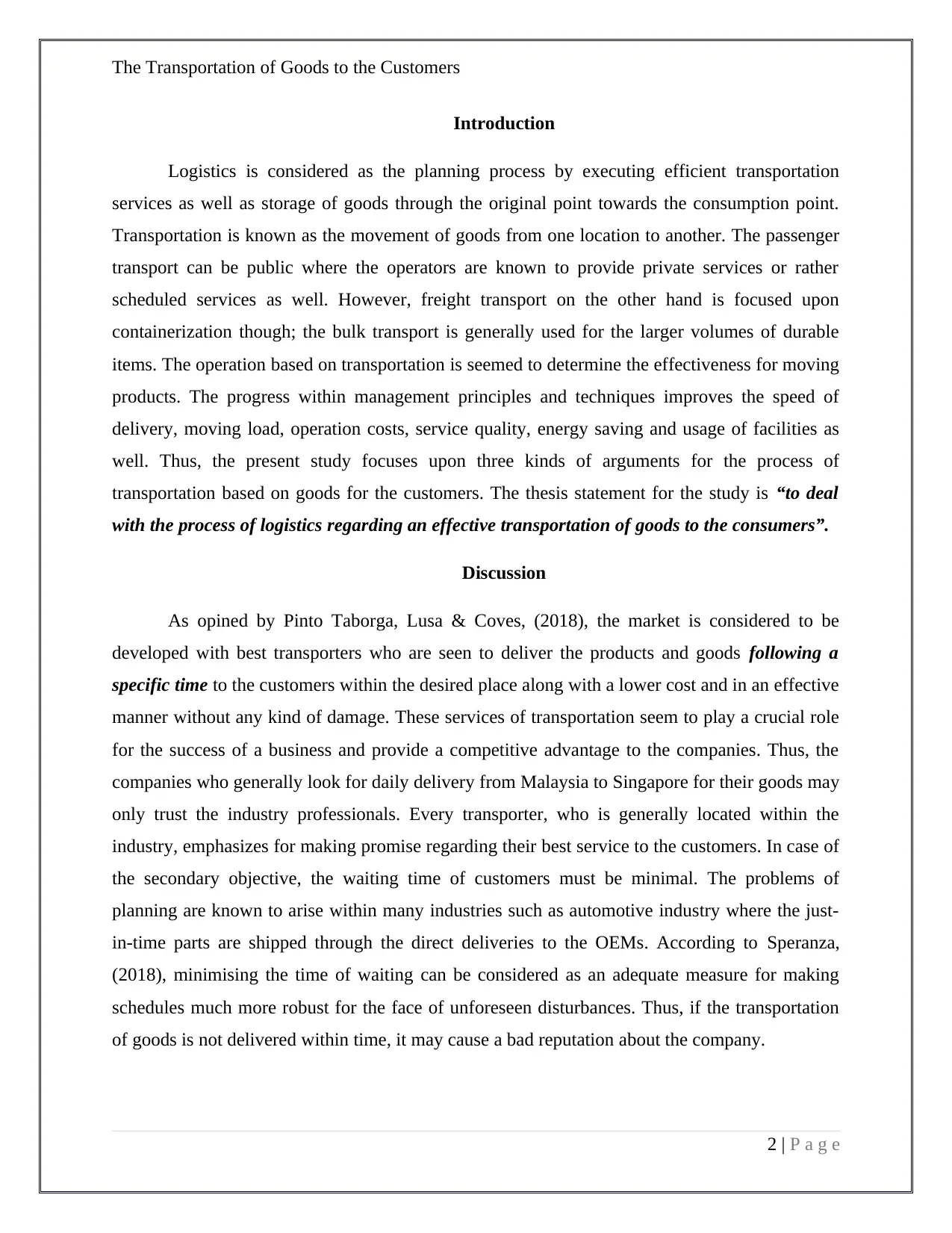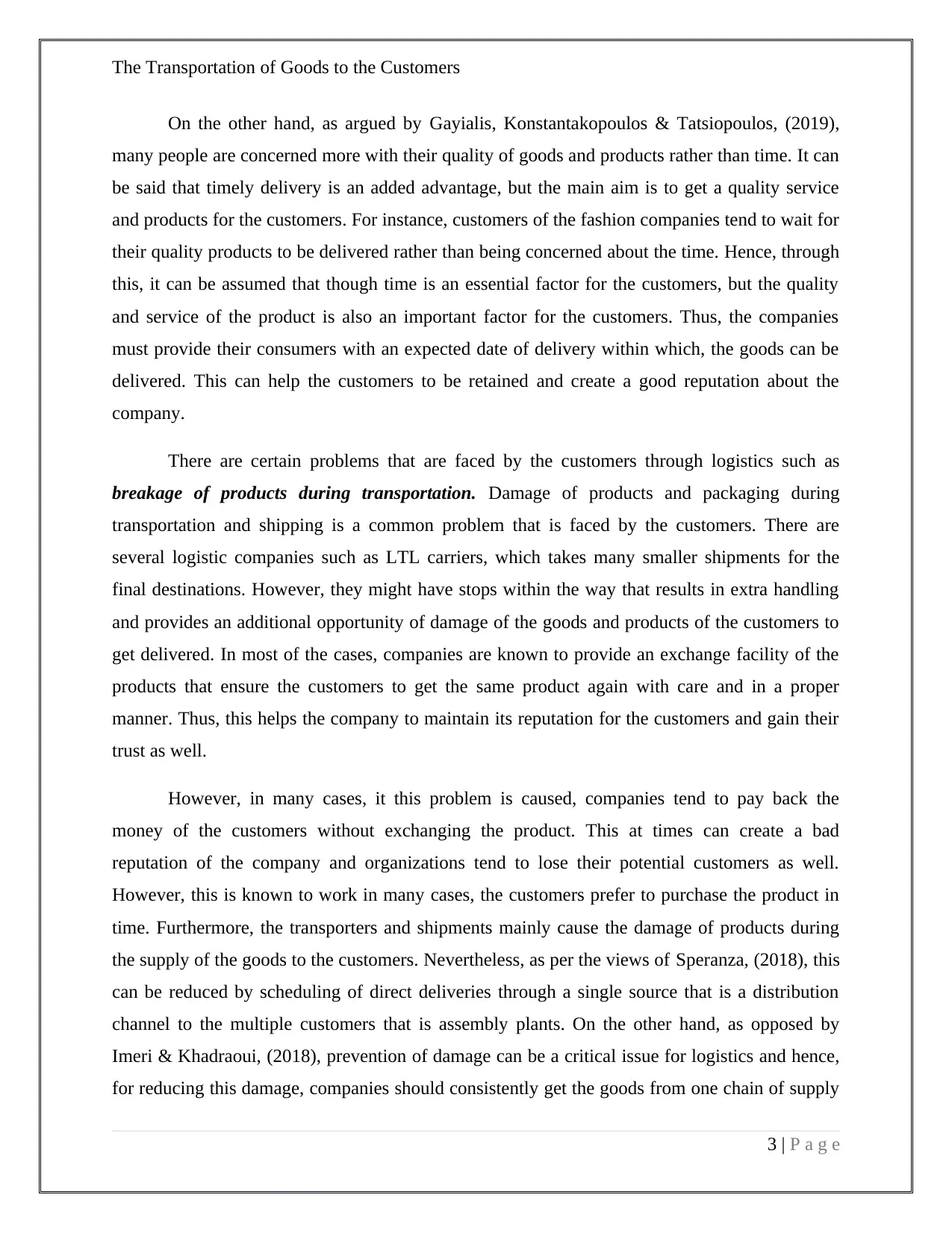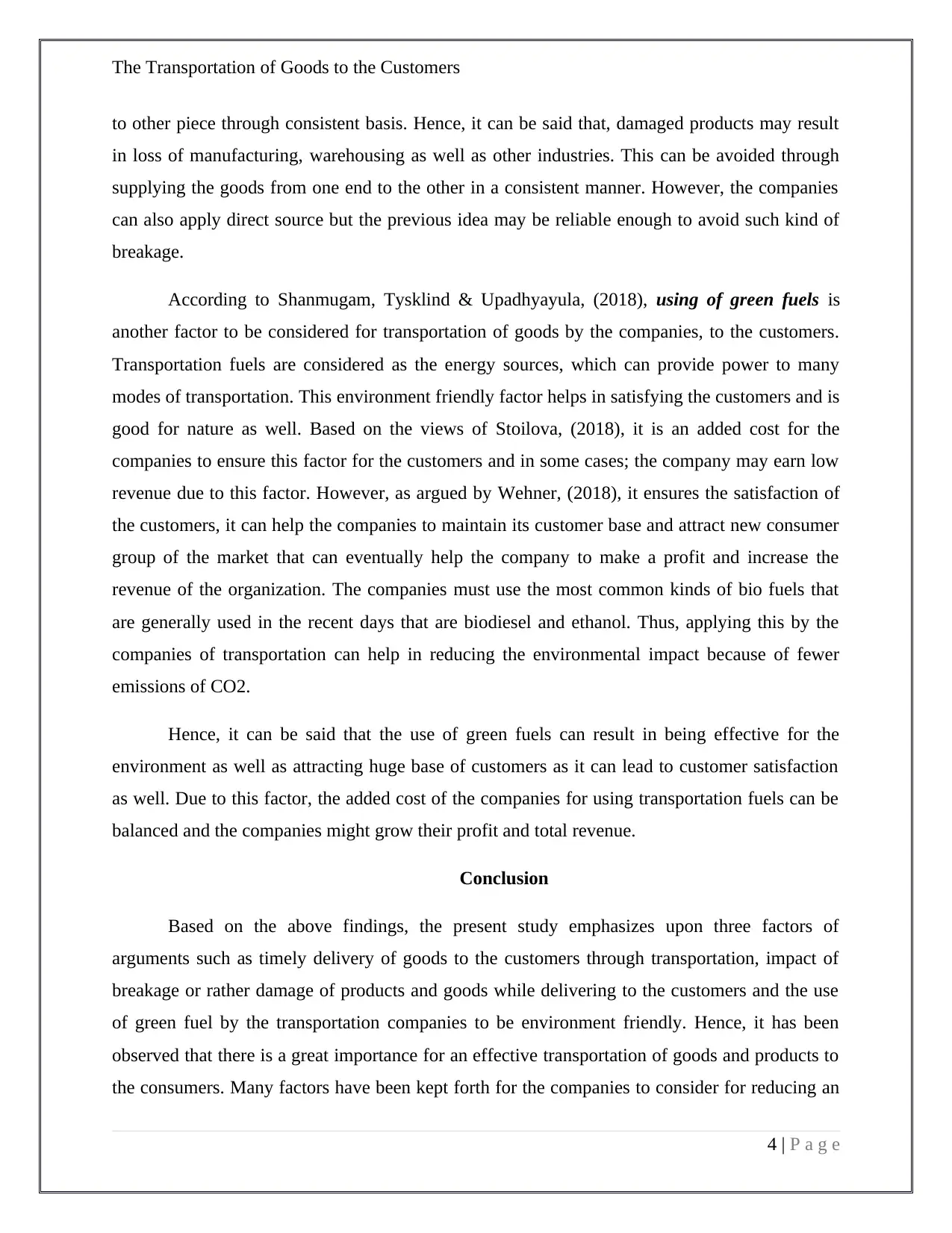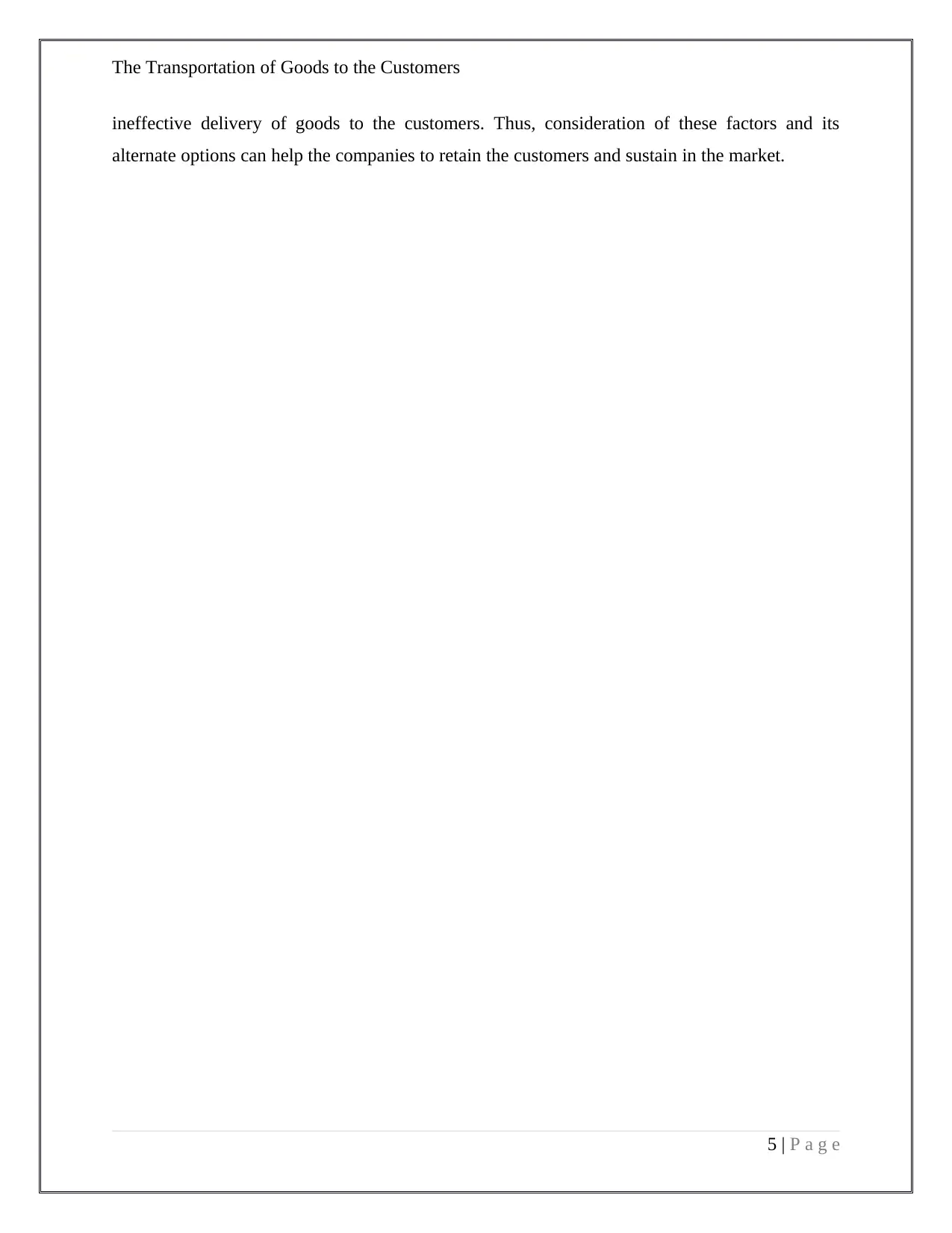An Analysis of the Transportation of Goods to the Customers
VerifiedAdded on 2023/01/05
|6
|1757
|27
Essay
AI Summary
This essay delves into the critical aspects of transporting goods to customers, focusing on three primary arguments: the importance of timely delivery, the impact of product damage, and the use of green fuels. The paper emphasizes that effective transportation is crucial for business success, highlighting the need for reliable and efficient services. It explores the significance of minimizing waiting times, ensuring product quality, and providing accurate delivery dates to retain customers. The essay also addresses the challenges of product damage during transportation, suggesting solutions such as direct deliveries and consistent supply chains. Furthermore, it examines the role of green fuels in satisfying customers and reducing environmental impact. The study concludes by underscoring the need for companies to consider these factors to enhance customer satisfaction and maintain a competitive edge in the market.

Running Head: The Transportation of Goods to the Customers
THE TRANSPORTATION OF GOODS TO THE
CUSTOMER
THE TRANSPORTATION OF GOODS TO THE
CUSTOMER
Paraphrase This Document
Need a fresh take? Get an instant paraphrase of this document with our AI Paraphraser

The Transportation of Goods to the Customers
Introduction
Logistics is considered as the planning process by executing efficient transportation
services as well as storage of goods through the original point towards the consumption point.
Transportation is known as the movement of goods from one location to another. The passenger
transport can be public where the operators are known to provide private services or rather
scheduled services as well. However, freight transport on the other hand is focused upon
containerization though; the bulk transport is generally used for the larger volumes of durable
items. The operation based on transportation is seemed to determine the effectiveness for moving
products. The progress within management principles and techniques improves the speed of
delivery, moving load, operation costs, service quality, energy saving and usage of facilities as
well. Thus, the present study focuses upon three kinds of arguments for the process of
transportation based on goods for the customers. The thesis statement for the study is “to deal
with the process of logistics regarding an effective transportation of goods to the consumers”.
Discussion
As opined by Pinto Taborga, Lusa & Coves, (2018), the market is considered to be
developed with best transporters who are seen to deliver the products and goods following a
specific time to the customers within the desired place along with a lower cost and in an effective
manner without any kind of damage. These services of transportation seem to play a crucial role
for the success of a business and provide a competitive advantage to the companies. Thus, the
companies who generally look for daily delivery from Malaysia to Singapore for their goods may
only trust the industry professionals. Every transporter, who is generally located within the
industry, emphasizes for making promise regarding their best service to the customers. In case of
the secondary objective, the waiting time of customers must be minimal. The problems of
planning are known to arise within many industries such as automotive industry where the just-
in-time parts are shipped through the direct deliveries to the OEMs. According to Speranza,
(2018), minimising the time of waiting can be considered as an adequate measure for making
schedules much more robust for the face of unforeseen disturbances. Thus, if the transportation
of goods is not delivered within time, it may cause a bad reputation about the company.
2 | P a g e
Introduction
Logistics is considered as the planning process by executing efficient transportation
services as well as storage of goods through the original point towards the consumption point.
Transportation is known as the movement of goods from one location to another. The passenger
transport can be public where the operators are known to provide private services or rather
scheduled services as well. However, freight transport on the other hand is focused upon
containerization though; the bulk transport is generally used for the larger volumes of durable
items. The operation based on transportation is seemed to determine the effectiveness for moving
products. The progress within management principles and techniques improves the speed of
delivery, moving load, operation costs, service quality, energy saving and usage of facilities as
well. Thus, the present study focuses upon three kinds of arguments for the process of
transportation based on goods for the customers. The thesis statement for the study is “to deal
with the process of logistics regarding an effective transportation of goods to the consumers”.
Discussion
As opined by Pinto Taborga, Lusa & Coves, (2018), the market is considered to be
developed with best transporters who are seen to deliver the products and goods following a
specific time to the customers within the desired place along with a lower cost and in an effective
manner without any kind of damage. These services of transportation seem to play a crucial role
for the success of a business and provide a competitive advantage to the companies. Thus, the
companies who generally look for daily delivery from Malaysia to Singapore for their goods may
only trust the industry professionals. Every transporter, who is generally located within the
industry, emphasizes for making promise regarding their best service to the customers. In case of
the secondary objective, the waiting time of customers must be minimal. The problems of
planning are known to arise within many industries such as automotive industry where the just-
in-time parts are shipped through the direct deliveries to the OEMs. According to Speranza,
(2018), minimising the time of waiting can be considered as an adequate measure for making
schedules much more robust for the face of unforeseen disturbances. Thus, if the transportation
of goods is not delivered within time, it may cause a bad reputation about the company.
2 | P a g e

The Transportation of Goods to the Customers
On the other hand, as argued by Gayialis, Konstantakopoulos & Tatsiopoulos, (2019),
many people are concerned more with their quality of goods and products rather than time. It can
be said that timely delivery is an added advantage, but the main aim is to get a quality service
and products for the customers. For instance, customers of the fashion companies tend to wait for
their quality products to be delivered rather than being concerned about the time. Hence, through
this, it can be assumed that though time is an essential factor for the customers, but the quality
and service of the product is also an important factor for the customers. Thus, the companies
must provide their consumers with an expected date of delivery within which, the goods can be
delivered. This can help the customers to be retained and create a good reputation about the
company.
There are certain problems that are faced by the customers through logistics such as
breakage of products during transportation. Damage of products and packaging during
transportation and shipping is a common problem that is faced by the customers. There are
several logistic companies such as LTL carriers, which takes many smaller shipments for the
final destinations. However, they might have stops within the way that results in extra handling
and provides an additional opportunity of damage of the goods and products of the customers to
get delivered. In most of the cases, companies are known to provide an exchange facility of the
products that ensure the customers to get the same product again with care and in a proper
manner. Thus, this helps the company to maintain its reputation for the customers and gain their
trust as well.
However, in many cases, it this problem is caused, companies tend to pay back the
money of the customers without exchanging the product. This at times can create a bad
reputation of the company and organizations tend to lose their potential customers as well.
However, this is known to work in many cases, the customers prefer to purchase the product in
time. Furthermore, the transporters and shipments mainly cause the damage of products during
the supply of the goods to the customers. Nevertheless, as per the views of Speranza, (2018), this
can be reduced by scheduling of direct deliveries through a single source that is a distribution
channel to the multiple customers that is assembly plants. On the other hand, as opposed by
Imeri & Khadraoui, (2018), prevention of damage can be a critical issue for logistics and hence,
for reducing this damage, companies should consistently get the goods from one chain of supply
3 | P a g e
On the other hand, as argued by Gayialis, Konstantakopoulos & Tatsiopoulos, (2019),
many people are concerned more with their quality of goods and products rather than time. It can
be said that timely delivery is an added advantage, but the main aim is to get a quality service
and products for the customers. For instance, customers of the fashion companies tend to wait for
their quality products to be delivered rather than being concerned about the time. Hence, through
this, it can be assumed that though time is an essential factor for the customers, but the quality
and service of the product is also an important factor for the customers. Thus, the companies
must provide their consumers with an expected date of delivery within which, the goods can be
delivered. This can help the customers to be retained and create a good reputation about the
company.
There are certain problems that are faced by the customers through logistics such as
breakage of products during transportation. Damage of products and packaging during
transportation and shipping is a common problem that is faced by the customers. There are
several logistic companies such as LTL carriers, which takes many smaller shipments for the
final destinations. However, they might have stops within the way that results in extra handling
and provides an additional opportunity of damage of the goods and products of the customers to
get delivered. In most of the cases, companies are known to provide an exchange facility of the
products that ensure the customers to get the same product again with care and in a proper
manner. Thus, this helps the company to maintain its reputation for the customers and gain their
trust as well.
However, in many cases, it this problem is caused, companies tend to pay back the
money of the customers without exchanging the product. This at times can create a bad
reputation of the company and organizations tend to lose their potential customers as well.
However, this is known to work in many cases, the customers prefer to purchase the product in
time. Furthermore, the transporters and shipments mainly cause the damage of products during
the supply of the goods to the customers. Nevertheless, as per the views of Speranza, (2018), this
can be reduced by scheduling of direct deliveries through a single source that is a distribution
channel to the multiple customers that is assembly plants. On the other hand, as opposed by
Imeri & Khadraoui, (2018), prevention of damage can be a critical issue for logistics and hence,
for reducing this damage, companies should consistently get the goods from one chain of supply
3 | P a g e
⊘ This is a preview!⊘
Do you want full access?
Subscribe today to unlock all pages.

Trusted by 1+ million students worldwide

The Transportation of Goods to the Customers
to other piece through consistent basis. Hence, it can be said that, damaged products may result
in loss of manufacturing, warehousing as well as other industries. This can be avoided through
supplying the goods from one end to the other in a consistent manner. However, the companies
can also apply direct source but the previous idea may be reliable enough to avoid such kind of
breakage.
According to Shanmugam, Tysklind & Upadhyayula, (2018), using of green fuels is
another factor to be considered for transportation of goods by the companies, to the customers.
Transportation fuels are considered as the energy sources, which can provide power to many
modes of transportation. This environment friendly factor helps in satisfying the customers and is
good for nature as well. Based on the views of Stoilova, (2018), it is an added cost for the
companies to ensure this factor for the customers and in some cases; the company may earn low
revenue due to this factor. However, as argued by Wehner, (2018), it ensures the satisfaction of
the customers, it can help the companies to maintain its customer base and attract new consumer
group of the market that can eventually help the company to make a profit and increase the
revenue of the organization. The companies must use the most common kinds of bio fuels that
are generally used in the recent days that are biodiesel and ethanol. Thus, applying this by the
companies of transportation can help in reducing the environmental impact because of fewer
emissions of CO2.
Hence, it can be said that the use of green fuels can result in being effective for the
environment as well as attracting huge base of customers as it can lead to customer satisfaction
as well. Due to this factor, the added cost of the companies for using transportation fuels can be
balanced and the companies might grow their profit and total revenue.
Conclusion
Based on the above findings, the present study emphasizes upon three factors of
arguments such as timely delivery of goods to the customers through transportation, impact of
breakage or rather damage of products and goods while delivering to the customers and the use
of green fuel by the transportation companies to be environment friendly. Hence, it has been
observed that there is a great importance for an effective transportation of goods and products to
the consumers. Many factors have been kept forth for the companies to consider for reducing an
4 | P a g e
to other piece through consistent basis. Hence, it can be said that, damaged products may result
in loss of manufacturing, warehousing as well as other industries. This can be avoided through
supplying the goods from one end to the other in a consistent manner. However, the companies
can also apply direct source but the previous idea may be reliable enough to avoid such kind of
breakage.
According to Shanmugam, Tysklind & Upadhyayula, (2018), using of green fuels is
another factor to be considered for transportation of goods by the companies, to the customers.
Transportation fuels are considered as the energy sources, which can provide power to many
modes of transportation. This environment friendly factor helps in satisfying the customers and is
good for nature as well. Based on the views of Stoilova, (2018), it is an added cost for the
companies to ensure this factor for the customers and in some cases; the company may earn low
revenue due to this factor. However, as argued by Wehner, (2018), it ensures the satisfaction of
the customers, it can help the companies to maintain its customer base and attract new consumer
group of the market that can eventually help the company to make a profit and increase the
revenue of the organization. The companies must use the most common kinds of bio fuels that
are generally used in the recent days that are biodiesel and ethanol. Thus, applying this by the
companies of transportation can help in reducing the environmental impact because of fewer
emissions of CO2.
Hence, it can be said that the use of green fuels can result in being effective for the
environment as well as attracting huge base of customers as it can lead to customer satisfaction
as well. Due to this factor, the added cost of the companies for using transportation fuels can be
balanced and the companies might grow their profit and total revenue.
Conclusion
Based on the above findings, the present study emphasizes upon three factors of
arguments such as timely delivery of goods to the customers through transportation, impact of
breakage or rather damage of products and goods while delivering to the customers and the use
of green fuel by the transportation companies to be environment friendly. Hence, it has been
observed that there is a great importance for an effective transportation of goods and products to
the consumers. Many factors have been kept forth for the companies to consider for reducing an
4 | P a g e
Paraphrase This Document
Need a fresh take? Get an instant paraphrase of this document with our AI Paraphraser

The Transportation of Goods to the Customers
ineffective delivery of goods to the customers. Thus, consideration of these factors and its
alternate options can help the companies to retain the customers and sustain in the market.
5 | P a g e
ineffective delivery of goods to the customers. Thus, consideration of these factors and its
alternate options can help the companies to retain the customers and sustain in the market.
5 | P a g e

The Transportation of Goods to the Customers
References
Gayialis, S. P., Konstantakopoulos, G. D., & Tatsiopoulos, I. P. (2019). Vehicle Routing
Problem for Urban Freight Transportation: A Review of the Recent Literature.
In Operational Research in the Digital Era–ICT Challenges (pp. 89-104). Springer,
Cham.
Imeri, A., & Khadraoui, D. (2018, February). The security and traceability of shared information
in the process of transportation of dangerous goods. In 2018 9th IFIP International
Conference on New Technologies, Mobility and Security (NTMS) (pp. 1-5). IEEE.
Pinto Taborga, C., Lusa, A., & Coves, A. M. (2018). A proposal for a green supply chain
strategy. Journal of Industrial Engineering and Management (JIEM), 11(3), 445-465.
Shanmugam, K., Tysklind, M., & Upadhyayula, V. K. (2018). Use of liquefied biomethane
(LBM) as a vehicle fuel for road freight transportation: A case study evaluating
environmental performance of using LBM for operation of tractor trailers. Procedia
CIRP, 69, 517-522.
Speranza, M. G. (2018). Operations research in transportation and supply chain management.
In New Trends in Emerging Complex Real Life Problems (pp. 13-21). Springer, Cham.
Speranza, M. G. (2018). Trends in transportation and logistics. European Journal of Operational
Research, 264(3), 830-836.
Stoilova, S. (2018). Evaluation efficiency of intermodal transport using multi-criteria analysis.
In Proceedings of 17th International Scientific Conference Engineering for Rural
Development, Jelgava, Latvia (pp. 2030-2039).
Wehner, J. (2018). Energy Efficiency in Logistics: An Interactive Approach to Capacity
Utilisation. Sustainability, 10(6), 1727.
6 | P a g e
References
Gayialis, S. P., Konstantakopoulos, G. D., & Tatsiopoulos, I. P. (2019). Vehicle Routing
Problem for Urban Freight Transportation: A Review of the Recent Literature.
In Operational Research in the Digital Era–ICT Challenges (pp. 89-104). Springer,
Cham.
Imeri, A., & Khadraoui, D. (2018, February). The security and traceability of shared information
in the process of transportation of dangerous goods. In 2018 9th IFIP International
Conference on New Technologies, Mobility and Security (NTMS) (pp. 1-5). IEEE.
Pinto Taborga, C., Lusa, A., & Coves, A. M. (2018). A proposal for a green supply chain
strategy. Journal of Industrial Engineering and Management (JIEM), 11(3), 445-465.
Shanmugam, K., Tysklind, M., & Upadhyayula, V. K. (2018). Use of liquefied biomethane
(LBM) as a vehicle fuel for road freight transportation: A case study evaluating
environmental performance of using LBM for operation of tractor trailers. Procedia
CIRP, 69, 517-522.
Speranza, M. G. (2018). Operations research in transportation and supply chain management.
In New Trends in Emerging Complex Real Life Problems (pp. 13-21). Springer, Cham.
Speranza, M. G. (2018). Trends in transportation and logistics. European Journal of Operational
Research, 264(3), 830-836.
Stoilova, S. (2018). Evaluation efficiency of intermodal transport using multi-criteria analysis.
In Proceedings of 17th International Scientific Conference Engineering for Rural
Development, Jelgava, Latvia (pp. 2030-2039).
Wehner, J. (2018). Energy Efficiency in Logistics: An Interactive Approach to Capacity
Utilisation. Sustainability, 10(6), 1727.
6 | P a g e
⊘ This is a preview!⊘
Do you want full access?
Subscribe today to unlock all pages.

Trusted by 1+ million students worldwide
1 out of 6
Related Documents
Your All-in-One AI-Powered Toolkit for Academic Success.
+13062052269
info@desklib.com
Available 24*7 on WhatsApp / Email
![[object Object]](/_next/static/media/star-bottom.7253800d.svg)
Unlock your academic potential
Copyright © 2020–2025 A2Z Services. All Rights Reserved. Developed and managed by ZUCOL.





